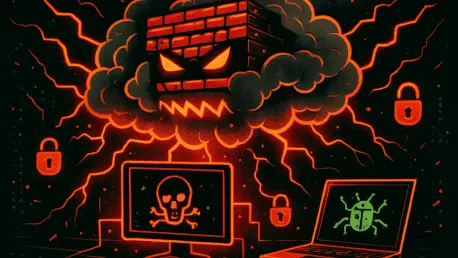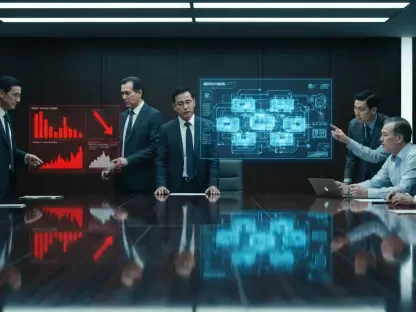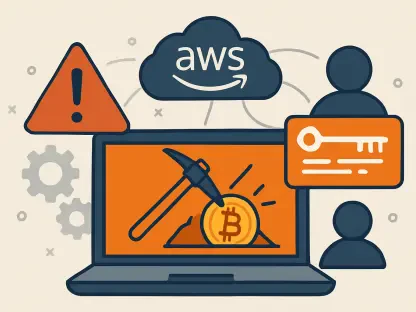What happens when the weakest link in a company’s network isn’t a password or a phishing email, but a forgotten device sitting quietly in the corner of the server room? A chilling revelation from Google’s Threat Intelligence Group has exposed a stealthy cyber threat known as Brickstorm malware, which has been infiltrating US firms across critical sectors for over a year. This isn’t just a routine cybersecurity alert; it’s a stark reminder of how unseen vulnerabilities can become gateways for sophisticated adversaries aiming to steal trade secrets and compromise national interests.
The significance of this threat cannot be overstated. Brickstorm, orchestrated by the suspected China-nexus group UNC5221, targets industries like technology, legal, SaaS, and business process outsourcing, with an average dwell time of 393 days inside compromised systems. This prolonged undetected presence signals a shift toward long-term espionage over quick financial gain, posing risks to intellectual property and sensitive data. As state-sponsored cyber operations grow bolder, understanding and countering this malware becomes a priority for businesses and policymakers alike.
A Silent Intruder in the Digital Shadows
Brickstorm malware operates with a level of stealth that makes it particularly insidious. Unlike flashy ransomware attacks that demand immediate attention, this threat slips through cracks in overlooked hardware, specifically targeting Linux devices and BSD-based appliances. These often-ignored components, frequently absent from asset inventories, provide the perfect entry point for attackers to establish a foothold without raising alarms.
The tactics employed by UNC5221 reveal a calculated approach to persistence. Once inside, the malware moves laterally across networks, harvesting credentials and deploying webshells for remote access. A particularly cunning method involves cloning virtual machines without powering them on, a move designed to evade detection by standard security tools. This level of sophistication underscores how traditional defenses are often outpaced by modern cyber threats.
National Stakes in a Cyber Battlefield
The implications of Brickstorm extend far beyond individual companies, touching on broader national concerns. With targets spanning multiple sectors, including legal firms handling sensitive national security or trade-related data, the campaign hints at motives tied to geopolitical strategy. The potential loss of intellectual property in technology and SaaS industries could undermine competitive edges critical to US economic strength.
Moreover, the strategic targeting of SaaS providers amplifies the threat’s reach. By compromising these providers, attackers gain access to downstream customers, creating a ripple effect that could impact countless businesses. Cybersecurity experts warn that such tactics reflect a growing trend of state-aligned groups prioritizing long-term access over immediate payouts, a shift that demands urgent attention from both private and public sectors.
Decoding the Enemy’s Playbook
Delving into UNC5221’s methods reveals a masterclass in covert operations. The group exploits zero-day vulnerabilities in peripheral devices, capitalizing on the fact that many organizations lack comprehensive visibility into their full network inventory. This blind spot allows attackers to establish backdoors, often remaining undetected for months or even years.
Beyond initial entry, the malware’s ability to escalate privileges is alarming. Reports indicate that UNC5221 targets VMware vCenter and ESXi hosts, using stolen credentials to modify startup scripts and install persistent access points. Such techniques demonstrate an intimate understanding of enterprise environments, making it clear that defending against this threat requires more than just patching known vulnerabilities—it demands a complete overhaul of security awareness.
Voices from the Frontline of Defense
Insights from industry leaders paint a sobering picture of the challenge ahead. Google’s Threat Intelligence Group, alongside cybersecurity firm Mandiant, has highlighted UNC5221’s operational discipline as a key factor in evading traditional detection methods. Mandiant’s analysis stresses, “Static indicators of compromise are no longer enough; organizations must pivot to proactive threat hunting based on tactics, techniques, and procedures to stay ahead of such adversaries.”
These expert perspectives emphasize the need for a mindset shift in cybersecurity. Relying solely on antivirus software or outdated protocols leaves firms vulnerable to groups with the expertise to adapt and innovate. The consensus is clear: businesses must invest in dynamic, behavior-based monitoring to identify anomalies before they escalate into full-blown breaches.
Building a Stronger Fortress Against Brickstorm
Confronting a threat as elusive as Brickstorm demands actionable, forward-thinking strategies. First, companies should prioritize updating their asset inventories to include all network devices, especially peripheral Linux and BSD appliances that often go unmonitored. Without a clear map of every connected component, blind spots will continue to serve as entry points for attackers.
Additionally, enhancing network visibility through continuous traffic monitoring can help detect unusual patterns indicative of lateral movement or data exfiltration. Implementing multi-factor authentication across all systems is another critical step to prevent privilege escalation. Finally, adopting a tactics, techniques, and procedures-based threat hunting approach, as advocated by Mandiant, enables firms to spot stealthy adversaries early, shifting the balance from reaction to prevention.
Reflecting on the battle against Brickstorm malware, it became evident that the fight demanded unprecedented vigilance from US firms. The stealth and persistence of UNC5221 had exposed critical gaps in cybersecurity practices, prompting a reevaluation of how businesses safeguarded their digital assets. Moving forward, the lessons learned pointed toward a future where comprehensive asset visibility, robust authentication protocols, and proactive threat hunting became non-negotiable pillars of defense. As cyber adversaries continued to evolve, the path ahead rested on sustained collaboration between private industries and government entities to fortify national resilience against such sophisticated threats.









